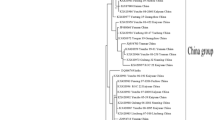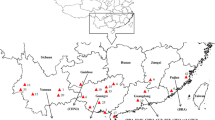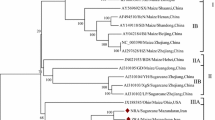Summary.
The genetic diversity of sugarcane yellow leaf virus (SCYLV) was analyzed with 43 virus isolates from Réunion Island and 17 isolates from world-wide locations. We attempted to amplify by reverse-transcription polymerase chain reaction (RT-PCR), clone, and sequence four different fragments covering 72% of the genome of these virus isolates. The number of amplified isolates and useful sequence information varied according to each fragment, whereas an amplicon was obtained with diagnostic primers for 59 out of 60 isolates (98%). Phylogenetic analyses of the sequences determined here and additional sequences of 11 other SCYLV isolates available from GenBank showed that SCYLV isolates were distributed in different phylogenetic groups or belonged to single genotypes. The majority of isolates from Réunion Island were grouped in phylogenetic clusters that did not contain any isolates from other origins. The complete six ORFs (5612 bp) of five SCYLV isolates (two from Réunion Island, one from Brazil, one from China, and one from Peru) were amplified, cloned, and sequenced. The existence of at least three distinct genotypes of SCYLV was shown by phylogenetic analysis of the sequences of these isolates and additional published sequences of three SCYLV isolates (GenBank accessions). The biological significance of these genotypes and of the origin of the distinct lineage of SCYLV in Réunion Island remains to be determined.
Similar content being viewed by others
References
OM Alegria M Chatenet J-C Girard SA Saldarriaga A Nuget P Rott (2000) ArticleTitleFirst report of Sugarcane yellow leaf virus in Peru Plant Dis 84 1342
Borg Z, Gibbs M, Lockhart B, Braithwaite K, Smith G (1999) Sugarcane yellow leaf virus: a novel recombinant virus from the Luteoviridae. In: Proc, XIth International Congress of Virology, Sydney 1999. International Union of Microbiological Societies, Sydney, p 47 (VW15.02:47)
Borg Z, Moonan F, Braithwaite K, Mirkov TE, Smith G (2001) Characterising the genetic diversity of Sugarcane yellow leaf virus. In: Proc, 24th International Society of Sugar Cane Technologists Congress, Brisbane 2001. The Australian Society of Sugar Cane Technologists, Mackay, pp 654–656
Burnquist WL, Vega J (1996) Sugarcane diseases in southern Brazil: a brief report. In: Croft BJ, Piggin CM, Wallis ES, Hogarth DM (eds) Sugarcane germplasm conservation and exchange, ACIAR Proc No. 67. The Australian Centre for International Agricultural Research, Canberra, pp 59–61
BA Chaloub HD Lapierre (1995) ArticleTitleImportance des recombinaisons ARN dans l’évolution des Luteovirus Agronomie 15 393–400
M Chatenet C Delage M Ripolles MS Irey BEL Lockhart P Rott (2001) ArticleTitleDetection of Sugarcane yellow leaf virus in quarantine and production of virus-free sugarcane by apical meristem culture Plant Dis 85 1177–1180
JC Comstock MS Irey BEL Lockhart ZK Wang (1998) ArticleTitleIncidence of yellow leaf syndrome in CP cultivars based on polymerase chain reaction and serological techniques Sugar Cane 4 21–24
CJ D’Arcy LL Domier (2005) Luteoviridae CM Fauquet MA Mayo J Maniloff U Desselberger LA Ball (Eds) Virus Taxonomy SeriesTitleVIIIth Report of the International Committee on Taxonomy of Viruses Academic Press New York 343–352
Girard J-C, Payet J (1997) La maîtrise des maladies de la canne à sucre à La Réunion: un effort continu de lutte depuis plus de soixante ans. In: Proc, 4e congrès international de l’Association réunionnaise pour le développement de la technologie agricole et sucrière (ARTAS) et 2es rencontres en langue française de l’Association française de la canne à sucre (AFCAS), Saint-Denis, La Réunion, 1997. ARTAS, Saint-Denis, pp 249–259
MP Grisham YB Pan WH White MA Godshall BL Legendre JC Comstock (2002) ArticleTitlePotential effect of yellow leaf syndrome on the Louisiana sugarcane industry J Am Soc Sugar Cane Technol 22 125–126
Lehrer AT, Schenck S, Fitch MMM, Moore PH, Komor E (2001) Distribution and transmission of Sugarcane yellow leaf virus (SCYLV) in Hawaii and its elimination from seedcane. In: Proc, 24th International Society of Sugar Cane Technologists Congress, Brisbane 2001. The Australian Society of Sugar Cane Technologists, Mackay, pp 439–443
BEL Lockhart CPR Cronjé (2000) Yellow leaf syndrome P Rott RA Bailey JC Comstock BJ Croft AS Saumtally (Eds) A guide to sugarcane diseases La Librairie du Cirad Montpellier 291–295
IG Maia MC Gonçalves P Arruda J Vega (2000) ArticleTitleMolecular evidence that sugarcane yellow leaf virus (ScYLV) is a member of the Luteoviridae family Arch Virol 145 1009–1019 Occurrence Handle10881686 Occurrence Handle1:CAS:528:DC%2BD3cXksVeksL0%3D Occurrence Handle10.1007/s007050050691
MA Mayo WA Miller (1999) The structure and expression of Luteovirus genomes HG Smith H Barker (Eds) The Luteoviridae CABI Publishing Wallingford, Oxon 23–42
F Moonan J Molina TE Mirkov (2000) ArticleTitleSugarcane yellow leaf virus: an emerging virus that has evolved by recombination between luteoviral and poleroviral ancestors Virology 269 156–171 Occurrence Handle10725208 Occurrence Handle1:CAS:528:DC%2BD3cXhvVSmsrw%3D Occurrence Handle10.1006/viro.1999.0162
F Moonan TE Mirkov (2002) ArticleTitleAnalyses of the genotypic diversity among North, South, and Central American isolates of Sugarcane yellow leaf virus. Evidence for Colombian origins and for intraspecific spatial phylogenetic variation J Virol 76 1339–1348 Occurrence Handle11773408 Occurrence Handle1:CAS:528:DC%2BD38XnvFCrtw%3D%3D
M Peterschmitt M Granier R Frutos B Reynaud (1996) ArticleTitleInfectivity and complete nucleotide sequence of the genome of a genetically distinct strain of Maize streak virus from Réunion Island Arch Virol 141 1637–1650 Occurrence Handle8893787 Occurrence Handle1:CAS:528:DyaK28XmvVChtbg%3D Occurrence Handle10.1007/BF01718288
L Rassaby J-C Girard MS Irey BEL Lockhart P Rott (1999) ArticleTitleSurvey of sugarcane yellow leaf syndrome in Réunion Island Sugar Cane 10 16–18
L Rassaby J-C Girard O Lemaire L Costet MS Irey H Kodja BEL Lockhart P Rott (2004) ArticleTitleSpread of Sugarcane yellow leaf virus in sugarcane plants and fields on the Island of Réunion Plant Pathol 53 117–125 Occurrence Handle10.1111/j.1365-3059.2004.00950.x
L Rassaby J-C Girard P Letourmy J Chaume MS Irey BEL Lockhart H Kodja P Rott (2003) ArticleTitleImpact of Sugarcane yellow leaf virus on sugarcane yield and juice quality in Réunion Island Eur J Plant Pathol 109 459–466 Occurrence Handle10.1023/A:1024211823306
SM Scagliusi BEL Lockhart (2000) ArticleTitleTransmission, characterisation, and serology of a Luteovirus associated with yellow leaf syndrome of sugarcane Phytopathology 90 120–124
S Schenck (2001) Sugarcane yellow leaf syndrome: history and current concepts GP Rao RE Ford M Tosic DS Teakle (Eds) Sugarcane pathology SeriesTitleVirus and phytoplasma diseases NumberInSeriesII Science Publishers Inc Enfield, NH 25–35
S Schenck AT Lehrer (2000) ArticleTitleFactors affecting the transmission and spread of Sugarcane yellow leaf virus Plant Dis 84 1085–1088
S Schenck JS Hu BEL Lockhart (1997) ArticleTitleUse of a tissue blot immunoassay to determine the distribution of Sugarcane yellow leaf virus in Hawaii Sugar Cane 4 5–8
GR Smith Z Borg BEL Lockhart KS Braithwaite M Gibbs (2000) ArticleTitleSugarcane yellow leaf virus: a novel member of the Luteoviridae that probably arose by inter-species recombination J Gen Virol 81 1865–1869 Occurrence Handle10859394 Occurrence Handle1:CAS:528:DC%2BD3cXks12hs7w%3D
HG Smith H Barker (1999) The Luteoviridae CABI Publishing Wallingford, Oxon
F Van der Wilk P Houterman J Moltoff F Hans F Dekker JFJM Van den Heuvel H Huttinga R Goldbach (1997) ArticleTitleExpression of the Potato leafroll virus ORF 0 induces viral-disease-like symptoms in transgenic potato plants Mol Plant-Microbe Interact 10 153–159 Occurrence Handle9057321 Occurrence Handle1:CAS:528:DyaK2sXhsFKhs74%3D
J Vega SMM Scagliusi EC Ulian (1997) ArticleTitleSugarcane yellow leaf disease in Brazil: evidence of association with a luteovirus Plant Dis 81 21–26
V Ziegler-Graff V Brault JD Mutterer MT Simonis E Herrbach H Guilley KE Richards G Jonard (1996) ArticleTitleThe coat protein of beet western yellows luteovirus is essential for systemic infection but the viral gene products P29 and P19 are dispensable for systemic infection and aphid transmission Mol Plant-Microbe Interact 9 501–510 Occurrence Handle1:CAS:528:DyaK28XkslOqt74%3D
Author information
Authors and Affiliations
Rights and permissions
About this article
Cite this article
Abu Ahmad, Y., Rassaby, L., Royer, M. et al. Yellow leaf of sugarcane is caused by at least three different genotypes of sugarcane yellow leaf virus, one of which predominates on the Island of Réunion. Arch Virol 151, 1355–1371 (2006). https://doi.org/10.1007/s00705-005-0712-9
Received:
Accepted:
Published:
Issue Date:
DOI: https://doi.org/10.1007/s00705-005-0712-9




